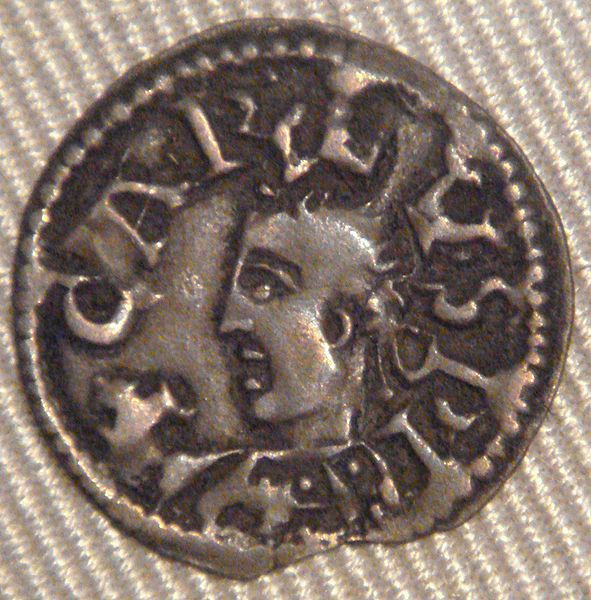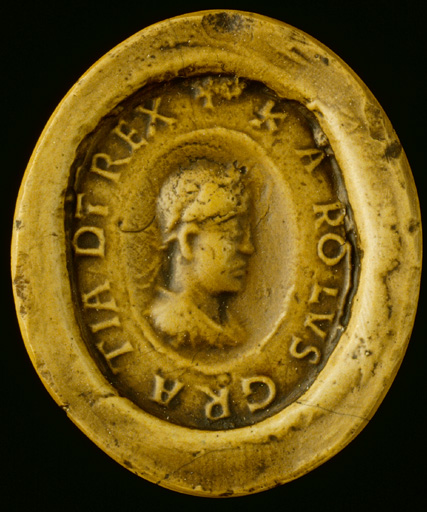<Back to Index>
- Physicist James Clerk Maxwell, 1831
- Author William Butler Yeats, 1865
- Holy Roman Emperor Charles the Bald, 823


Charles the Bald (13 June 823 – 6 October 877), Holy Roman Emperor (875–877, as Charles II) and King of West Francia (840–877, as Charles II, with the borders of his land defined by the Treaty of Verdun, 843), was the youngest son of the Emperor Louis the Pious by his second wife Judith.
He was born on 13 June 823 in Frankfurt, when his elder brothers were already adults and had been assigned their own regna, or subkingdoms, by their father. The attempts made by Louis the Pious to assign Charles a subkingdom, first Alemannia and then the country between the Meuse and the Pyrenees (in 832, after the rising of Pepin I of Aquitaine) were unsuccessful. The numerous reconciliations with the rebellious Lothair and Pepin, as well as their brother Louis the German, King of Bavaria, made Charles's share in Aquitaine and Italy only temporary, but his father did not give up and made Charles the heir of the entire land which was once Gaul and would eventually be France. At a diet near Crémieux in 837, Louis the Pious bade the nobles do homage to Charles as his heir. This led to the final rising of his sons against him and Pepin of Aquitaine died in 838, whereupon Charles received that kingdom, finally once and for all. Pepin's son Pepin II would be a perpetual thorn in his side.
The
death of the emperor in 840 led to the outbreak of war between his
sons. Charles allied himself with his brother Louis the German to
resist the pretensions of the new emperor Lothair I, and the two allies
defeated Lothair at the Battle of Fontenay-en-Puisaye on 25 June 841. In the following year, the two brothers confirmed their alliance by the celebrated Oaths of Strasbourg. The war was brought to an end by the Treaty of Verdun in
August 843. The settlement gave Charles the Bald the kingdom of the
West Franks, which he had been up till then governing and which
practically corresponded with what is now France, as far as the Meuse, the Saône, and the Rhône, with the addition of the Spanish March as far as the Ebro. Louis received the eastern part of the Carolingian Empire, known as the East Francia and later Germany. Lothair retained the imperial title and the Iron Crown of Lombardy. He also received the central regions from Flanders through the Rhineland and Burgundy as king of Middle Francia. The
first years of Charles's reign, up to the death of Lothair I in 855,
were comparatively peaceful. During these years the three brothers
continued the system of "confraternal government", meeting repeatedly
with one another, at Koblenz (848), at Meerssen (851), and at Attigny (854).
In 858, Louis the German, invited by disaffected nobles eager to oust
Charles, invaded the West Frankish kingdom. Charles was so unpopular
that he was unable to summon an army, and he fled to Burgundy. He was saved only by the support of the bishops, who refused to crown Louis king, and by the fidelity of the Welfs, who were related to his mother, Judith. In 860, he in his turn tried to seize the kingdom of his nephew, Charles of Provence, but was repulsed. On the death of his nephew Lothair II in 869, Charles tried to seize Lothair's dominions, but by the Treaty of Mersen (870) was compelled to share them with Louis the German. Besides these family disputes, Charles had to struggle against repeated rebellions in Aquitaine and against the Bretons. Led by their chiefs Nomenoë and Erispoë, who defeated the king at Ballon (845) and Juvardeil (851), the Bretons were successful in obtaining a de facto independence. Charles also fought against the Vikings, who devastated the country of the north, the valleys of the Seine and Loire,
and even up to the borders of Aquitaine. Several times Charles was
forced to purchase their retreat at a heavy price. Charles led various
expeditions against the invaders and, by the Edict of Pistres of 864, made the army more mobile by providing for a cavalry element, the predecessor of the French chivalry so
famous during the next 600 years. By the same edict, he ordered
fortified bridges to be put up at all rivers to block the Viking
incursions. Two of these bridges at Paris saved the city during its siege of 885–886. In 875, after the death of the Emperor Louis II (son of his half-brother Lothair), Charles the Bald, supported by Pope John VIII, traveled to Italy, receiving the royal crown at Pavia and
the imperial insignia in Rome on 29 December. Louis the German, also a
candidate for the succession of Louis II, revenged himself by invading
and devastating Charles' dominions, and Charles had to return hastily to Francia.
After the death of Louis the German (28 August 876), Charles in his
turn attempted to seize Louis's kingdom, but was decisively beaten at Andernach on 8 October 876. In the meantime, John VIII, menaced by the Saracens, was urging Charles to come to his defence in Italy. Charles again crossed the Alps, but this expedition was received with little enthusiasm by the nobles, and even by his regent in Lombardy, Boso, and they refused to join his army. At the same time Carloman,
son of Louis the German, entered northern Italy. Charles, ill and in
great distress, started on his way back to Gaul, but died while
crossing the pass of Mont Cenis at Brides-les-Bains, on 6 October 877. According
to the Annals of St-Bertin, Charles was hastily buried at the abbey of
Nantua, Burgundy because the bearers were unable to withstand the
stench of his decaying body. He was to have been buried in the Basilique Saint-Denis and
may have been transferred there later. It was recorded that there was a
memorial brass there that was melted down at the Revolution. Charles was succeeded by his son, Louis.
Charles was a prince of education and letters, a friend of the church,
and conscious of the support he could find in the episcopate against
his unruly nobles, for he chose his councillors from among the higher
clergy, as in the case of Guenelon of Sens, who betrayed him, and of Hincmar of Reims. It has been suggested that
Charles was not in fact bald, but that his epithet was applied
ironically — that, in fact, he was extremely hairy. In support of this
idea is the fact that none of his enemies commented on what would be an
easy target. However, none of the voluble members of his court comments
on his being hairy; and the Genealogy of Frankish Kings, a text from Fontanelle dating from possibly as early as 869, and a text without a trace of irony, names him as Karolus Caluus ("Charles the Bald"). Certainly, by the end of the 10th century, Richier of Reims and Adhemar of Chabannes refer to him in all seriousness as "Charles the Bald". An alternative or additional interpretation is based on Charles' initial lack of a regnum.
"Bald" would in this case be a tongue-in-cheek reference to his
landlessness, at an age where his brothers already had been sub-kings
for some years. Charles married Ermentrude, daughter of Odo I, Count of Orléans, in 842. She died in 869. In 870, Charles married Richilde of Provence, who was descended from a noble family of Lorraine. With Ermentrude he had nine children and with Richilde another five.